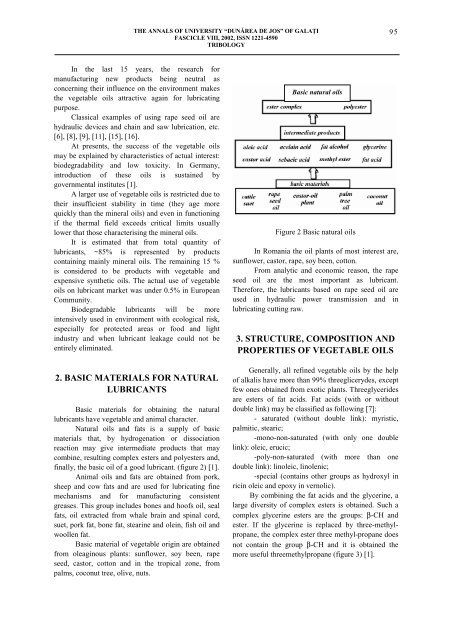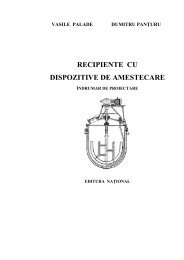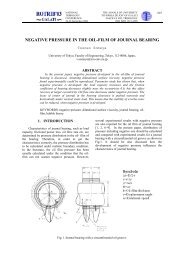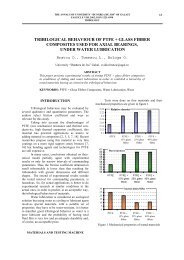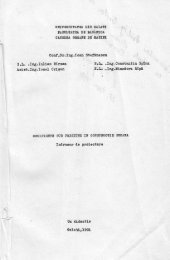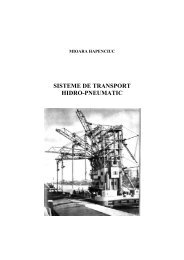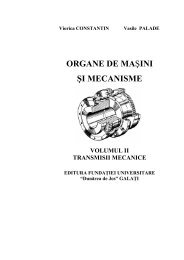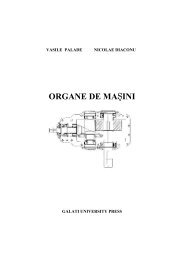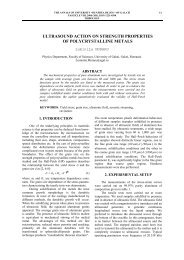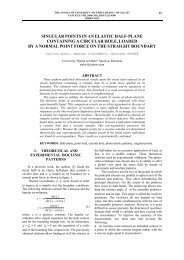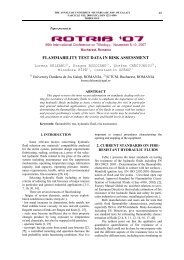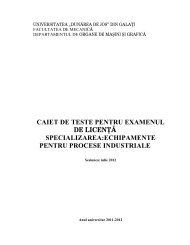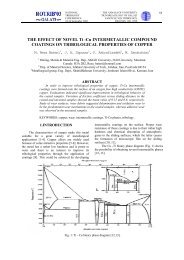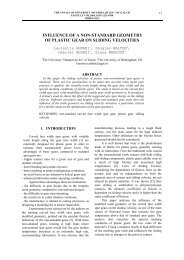on the future of biodegradable vegetable lubricants - Dunarea de Jos
on the future of biodegradable vegetable lubricants - Dunarea de Jos
on the future of biodegradable vegetable lubricants - Dunarea de Jos
You also want an ePaper? Increase the reach of your titles
YUMPU automatically turns print PDFs into web optimized ePapers that Google loves.
THE ANNALS OF UNIVERSITY “DUNĂREA DE JOS” OF GALAŢI<br />
FASCICLE VIII, 2002, ISSN 1221-4590<br />
TRIBOLOGY<br />
95<br />
In <strong>the</strong> last 15 years, <strong>the</strong> research for<br />
manufacturing new products being neutral as<br />
c<strong>on</strong>cerning <strong>the</strong>ir influence <strong>on</strong> <strong>the</strong> envir<strong>on</strong>ment makes<br />
<strong>the</strong> <strong>vegetable</strong> oils attractive again for lubricating<br />
purpose.<br />
Classical examples <strong>of</strong> using rape seed oil are<br />
hydraulic <strong>de</strong>vices and chain and saw lubricati<strong>on</strong>, etc.<br />
[6], [8], [9], [11], [15], [16].<br />
At presents, <strong>the</strong> success <strong>of</strong> <strong>the</strong> <strong>vegetable</strong> oils<br />
may be explained by characteristics <strong>of</strong> actual interest:<br />
bio<strong>de</strong>gradability and low toxicity. In Germany,<br />
introducti<strong>on</strong> <strong>of</strong> <strong>the</strong>se oils is sustained by<br />
governmental institutes [1].<br />
A larger use <strong>of</strong> <strong>vegetable</strong> oils is restricted due to<br />
<strong>the</strong>ir insufficient stability in time (<strong>the</strong>y age more<br />
quickly than <strong>the</strong> mineral oils) and even in functi<strong>on</strong>ing<br />
if <strong>the</strong> <strong>the</strong>rmal field exceeds critical limits usually<br />
lower that those characterising <strong>the</strong> mineral oils.<br />
It is estimated that from total quantity <strong>of</strong><br />
<strong>lubricants</strong>, ~85% is represented by products<br />
c<strong>on</strong>taining mainly mineral oils. The remaining 15 %<br />
is c<strong>on</strong>si<strong>de</strong>red to be products with <strong>vegetable</strong> and<br />
expensive syn<strong>the</strong>tic oils. The actual use <strong>of</strong> <strong>vegetable</strong><br />
oils <strong>on</strong> lubricant market was un<strong>de</strong>r 0.5% in European<br />
Community.<br />
Bio<strong>de</strong>gradable <strong>lubricants</strong> will be more<br />
intensively used in envir<strong>on</strong>ment with ecological risk,<br />
especially for protected areas or food and light<br />
industry and when lubricant leakage could not be<br />
entirely eliminated.<br />
2. BASIC MATERIALS FOR NATURAL<br />
LUBRICANTS<br />
Basic materials for obtaining <strong>the</strong> natural<br />
<strong>lubricants</strong> have <strong>vegetable</strong> and animal character.<br />
Natural oils and fats is a supply <strong>of</strong> basic<br />
materials that, by hydrogenati<strong>on</strong> or dissociati<strong>on</strong><br />
reacti<strong>on</strong> may give intermediate products that may<br />
combine, resulting complex esters and polyesters and,<br />
finally, <strong>the</strong> basic oil <strong>of</strong> a good lubricant. (figure 2) [1].<br />
Animal oils and fats are obtained from pork,<br />
sheep and cow fats and are used for lubricating fine<br />
mechanisms and for manufacturing c<strong>on</strong>sistent<br />
greases. This group inclu<strong>de</strong>s b<strong>on</strong>es and ho<strong>of</strong>s oil, seal<br />
fats, oil extracted from whale brain and spinal cord,<br />
suet, pork fat, b<strong>on</strong>e fat, stearine and olein, fish oil and<br />
woollen fat.<br />
Basic material <strong>of</strong> <strong>vegetable</strong> origin are obtained<br />
from oleaginous plants: sunflower, soy been, rape<br />
seed, castor, cott<strong>on</strong> and in <strong>the</strong> tropical z<strong>on</strong>e, from<br />
palms, coc<strong>on</strong>ut tree, olive, nuts.<br />
Basic natural oils<br />
Figure 2 Basic natural oils<br />
In Romania <strong>the</strong> oil plants <strong>of</strong> most interest are,<br />
sunflower, castor, rape, soy been, cott<strong>on</strong>.<br />
From analytic and ec<strong>on</strong>omic reas<strong>on</strong>, <strong>the</strong> rape<br />
seed oil are <strong>the</strong> most important as lubricant.<br />
Therefore, <strong>the</strong> <strong>lubricants</strong> based <strong>on</strong> rape seed oil are<br />
used in hydraulic power transmissi<strong>on</strong> and in<br />
lubricating cutting raw.<br />
3. STRUCTURE, COMPOSITION AND<br />
PROPERTIES OF VEGETABLE OILS<br />
Generally, all refined <strong>vegetable</strong> oils by <strong>the</strong> help<br />
<strong>of</strong> alkalis have more than 99% threeglicery<strong>de</strong>s, except<br />
few <strong>on</strong>es obtained from exotic plants. Threeglyceri<strong>de</strong>s<br />
are esters <strong>of</strong> fat acids. Fat acids (with or without<br />
double link) may be classified as following [7]:<br />
- saturated (without double link): myristic,<br />
palmitic, stearic;<br />
-m<strong>on</strong>o-n<strong>on</strong>-saturated (with <strong>on</strong>ly <strong>on</strong>e double<br />
link): oleic, erucic;<br />
-poly-n<strong>on</strong>-saturated (with more than <strong>on</strong>e<br />
double link): linoleic, linolenic;<br />
-special (c<strong>on</strong>tains o<strong>the</strong>r groups as hydroxyl in<br />
ricin oleic and epoxy in vernolic).<br />
By combining <strong>the</strong> fat acids and <strong>the</strong> glycerine, a<br />
large diversity <strong>of</strong> complex esters is obtained. Such a<br />
complex glycerine esters are <strong>the</strong> groups: β-CH and<br />
ester. If <strong>the</strong> glycerine is replaced by three-methylpropane,<br />
<strong>the</strong> complex ester three methyl-propane does<br />
not c<strong>on</strong>tain <strong>the</strong> group β-CH and it is obtained <strong>the</strong><br />
more useful threemethylpropane (figure 3) [1].


